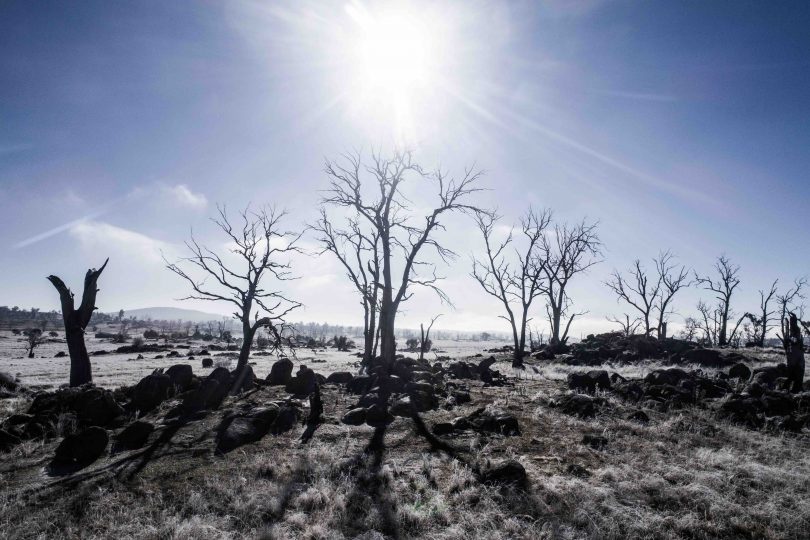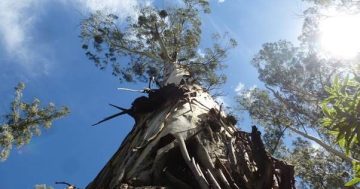
Widespread dieback, with different causes, has affected trees on the Monaro and now the high country. Photo: Sammy Hawker.
ANU scientists say there’s growing concern over a mysterious, possibly drought-related phenomenon that’s killing off substantial numbers of snow gums in the Australian Alps, and they’re calling on citizen scientists to help solve the puzzle.
Snow gum dieback has been observed across a wide area in the high country, affecting the white trunked Eucalyptus pauciflora. Also commonly known as the white sallee, the snow gums are generally thought to be among the hardiest of all eucalypt species and the only trees present above 1600 metres.
The bark sheds in patches or strips creating a mottled appearance that’s often spectacularly striped. It’s sometimes also known as the weeping gum as the branches bend under the weight of winter snow.
Dr Matthew Brookhouse from the ANU is heading the research project into snowgum dieback. He says a substantial area within Kosciuszko National Park, as well as Namadgi National Park and Victoria’s Alpine National Park, is affected by the widespread dieback event.
“We think it’s caused by infestations of Phoracantha beetles, which tunnel in and feed within the host trees,” he says.
It’s thought that a drought-stressed tree becomes more vulnerable to attack by the beetles, which begin in the upper branches and move towards the base of the tree. The beetle larvae then make deep, horizontal incisions in the tree as the bark dries out.
“These incisions are typically 2-4 centimetres wide and are often stained dark red on recently killed trees,” Dr Brookhouse said.
Snow gum dieback is most common in high elevation areas, between 1600 and 1800 metres, but because these areas are often wild and remote, analysing the extent and impact of the dieback is difficult for scientists. That makes observations from hikers, skiers and campers invaluable.
“We’re trying to determine the full extent of the phenomenon. We’re also keen to confirm the species of beetle responsible,” Dr Brookhouse said. “But we’re in urgent need of help from the general public because widespread dieback could have wide-ranging consequences.”

A snow gum affected by dieback with the characteristic horizontal borer scars. Photo: Supplied.
Affected trees are easily recognisable at close range. They will have no bark, no leaves and very prominent horizontal scars across the stem.
“Once you’ve seen some they are unforgettable. When I’ve shown photos to people, they instantly recognise the trees,” he says.
The high country tree deaths follow a devastating pattern of loss across the Monaro where tens of thousands of Eucalyptus viminalis have died over a 2,000 square km area between Cooma and Berridale over a 20-year span, although with different causes.
“If you think about the distribution of snow gums from the high elevation here in the Brindabellas through to Kosciuszko, these are geographically very remote stands of trees on mountain tops,” Dr Brookhouse says. “We need to either rely heavily on remote sensing or ground observations.”
Remote sensing has a number of problems: the snowgum stands are often too small to capture accurately and the extent of bushfires through the region in 2003 makes it hard to distinguish between trees that are being killed by insects and fire kills.
It’s also extremely expensive and the dieback project will require years’ worth of data to understand the environmental patterns. That’s where the citizen scientists come in.
“On the ground we need lots more people, whether they are based in resorts and riding bikes or hiking, or camping in the back country, riding horses, walking the Australian Alpine track or exploring very remote areas. They’re all covering ground our very small team can’t get to,” Dr Brookhouse says.
One major focus will be discovering which species of long-horned wood borer is responsible for the damage. To find out, the ANU team will spend three months trapping insects over summer to work out their life cycle.
“If snowgum bark is well hydrated, the borer larvae can’t penetrate through it,” Dr Brookhouse says. “But when the bark dries down to 45 per cent or less, they can penetrate the bark and survive.
“This is almost definitely a local insect, responding to changing conditions in the environment itself. So the problem is in the substrate, not with the insects.”
A snow-gum dieback survey has been set up so the public can add their findings, established with the help of the Atlas of Living Australia’s BioCollect program.
The survey can be accessed by downloading the BioCollect app and you can also upload information here.












